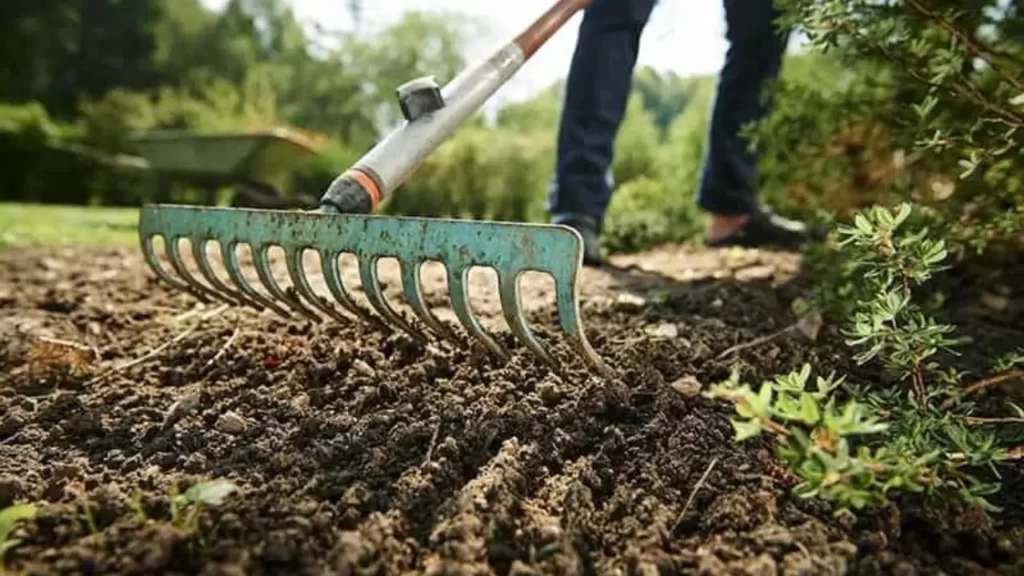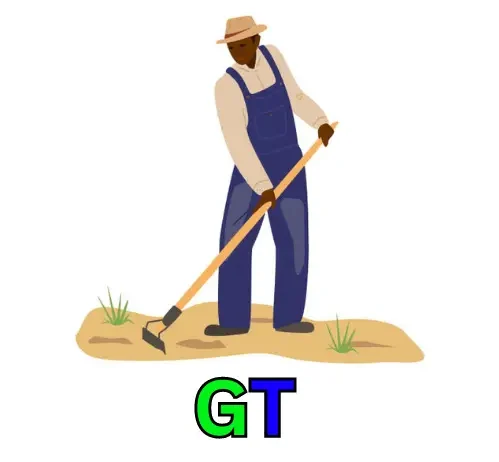Gardening is a satisfactory hobby that is loved by many peoples around the world. The gardening tools are helping hands for every Gardner which makes multiple gardening tasks easier and fast. The Garden Rake is one of the most helpful gardening tools which every gardener must have.
The Garden Rake offers several benefits that contribute to healthy plant growth and overall garden maintenance. So, here in this article let’s explore the Garde Rake, its types, benefits, and how to use it to make your gardening experience easier and more enjoyable.

What is a Garden Rake?
A Garden rake is a long-handled gardening tool that has a row of metal or plastic teeth attached to the head. This unique tool is designed to work through soil, gravel, or grass, allowing you to gather, level, and remove debris effectively. The rake’s sturdy construction ensures durability and reliability, making it a valuable asset for any gardener.
Types of Garden Rakes
There are different types of garden rakes available for different tasks and here are the most common types of garden rakes.
- Leaf Rake: As the name suggests this garden rake is designed to collect leaves and other lightweight debris.
- Lawn Rake: This type of garden rake is suitable for raking grass clippings and dethatching the lawn.
- Garden Rake: The garden rakes are suitable for general garden maintenance, such as clearing small rocks and leveling soil.
- Bow Rake: The bow rakes are made to do heavy-duty tasks such as breaking up soil and mulching also, they have sturdy tines made to do specific heavy-duty tasks.
These are the 4 common types of rakes that most people have in their gardening tool inventory.
Also Read: Garden Hoe vs Garden Rake Understanding the difference and functions

Different Functions of Garden Rake
Here are the different gardening tasks which you can do with the help of a rake.
- Clearing or collecting the debris and fallen leaves
- Preparing the soil for planting
- Leveling and smoothing the soil
- Removing the unwanted plants and weed
- Areation and enhancing the water absorption of the soil
- Spreading the mulch and compost
- To maintain the garden pathway
- Raking and collecting lawn clippings
- Preventing pest infestation
How To Choose the Right Rake for your garden
Here are some of the factors to be considered while choosing the rake for your gardening preferences.
- Purpose: Primarily determine the specific gardening tasks you want to do with the rake like raking leaves. clearing debris or leveling soil, etc. Different rakes are made for different tasks so choose the right one based on your needs.
- Rake Head Material: Choose the rake head with durable material like steel or plastic based on your gardening preferences. The metal head are suitable for heavy-duty tasks whereas plastic heads are suitable for light tasks.
- Rake Head Size: Rake head size is also an important factor to be considered. The wider head rakes are best for larger gardens and the narrow head rakes are suitable for small gardens.
- Number of Tines: The tines of the rake are also important when using the rake for different garden tasks. More tines cover better coverage which is suitable for raking leaves and debris. But for raking the soil or gravel fewer tines gives the best result. So it is your choice to choose the number of tines based on your garden preferences.
- Rake Handle Length: Choose a rake with a handle length that is comfortable for your height. A longer handle allows for extended reach and reduces the strain on your back while raking.
- Handle Material: Look for a handle with comfortable and sturdy materials like wood or fiberglass. Avoid the handle that is prone to splintering or bending.
- Weight: Consider the weight of the rake based on your gardening needs. The light rakes are suitable to maneuver, while heavier rakes provide more stability for tougher tasks.
These are the important factors to be considered while choosing the garden rake and choose one which fits under your budget.
Also Read: Half-Moon Edger vs Spade which is best for digging & edging

Maintenance and Cleaning of Rake
Follow these regular maintenance tips to keep the performance of the garden rake for a longer period and improve its lifespan.
- Clean the rake after every use, and remove debris and dirt from the blade.
- Wash the blade and dry it before storing it.
- Regularly sharpen the tines of rakes to maintain their performance.
- Store the rake in a well-ventilated area that does not have any moisture to prevent the blade from rust.
- If the rake is damaged heavily replace it rather than repairing it.
FAQs
Can I use a garden rake on different types of soil?
Yes, a garden rake is designed to use for different soil types like sand, clay, loam, etc.
How often should I rake my garden?
Generally, it is suggested to rake the garden once a week depending on the season and the amount of debris in your garden.
Can a garden rake be used for removing rocks from the soil?
Yes, a garden rake can be used to remove rocks and small stones from the soil.
Is a garden rake suitable for raking leaves on a lawn?
Yes, a garden rake can be used for raking leaves but a leaf rake is designed to do raking leaves so a leaf rake can more suitable for raking the leaves rather than a garden rake.
Can a garden rake be used for spreading gravel or leveling gravel pathways?
Yes, a garden rake can be used for spreading and leveling gravel. Its teeth help to distribute and even out the gravel, creating a smooth and level surface for pathways or driveways.
Also Read: Stirrup Hoe vs Dutch Hoe
Conclusion
A Graden Rakes is a helpful gardening tool that helps the gardener to maintain and clean the garden. Also, it can be used for different tasks, so there are different types of rake to do specific gardening tasks. So, choose the right rake for your garden and maintain it with proper care and storage to keep its performance and lifespan for a longer period of time.
